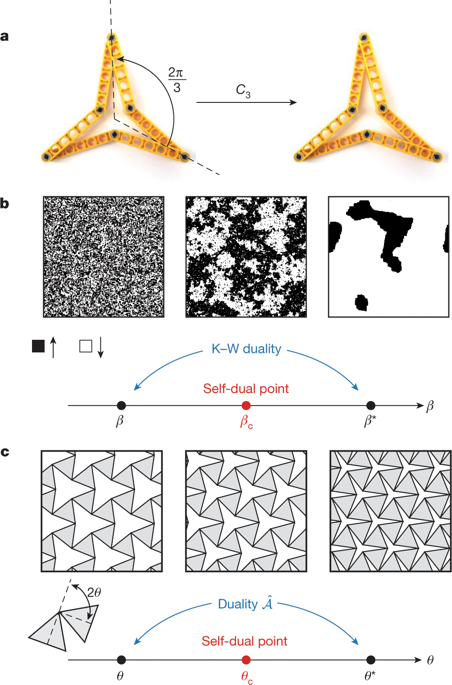Nature ( IF 64.8 ) Pub Date : 2020-01-20 , DOI: 10.1038/s41586-020-1932-6 Michel Fruchart 1, 2 , Yujie Zhou 3 , Vincenzo Vitelli 1, 2

|
Dualities are mathematical mappings that reveal links between apparently unrelated systems in virtually every branch of physics1,2,3,4,5,6,7,8. Systems mapped onto themselves by a duality transformation are called self-dual and exhibit remarkable properties, as exemplified by the scale invariance of an Ising magnet at the critical point. Here we show how dualities can enhance the symmetries of a dynamical matrix (or Hamiltonian), enabling the design of metamaterials with emergent properties that escape a standard group theory analysis. As an illustration, we consider twisted kagome lattices9,10,11,12,13,14,15, reconfigurable mechanical structures that change shape by means of a collapse mechanism9. We observe that pairs of distinct configurations along the mechanism exhibit the same vibrational spectrum and related elastic moduli. We show that these puzzling properties arise from a duality between pairs of configurations on either side of a mechanical critical point. The critical point corresponds to a self-dual structure with isotropic elasticity even in the absence of spatial symmetries and a twofold-degenerate spectrum over the entire Brillouin zone. The spectral degeneracy originates from a version of Kramers’ theorem16,17 in which fermionic time-reversal invariance is replaced by a hidden symmetry emerging at the self-dual point. The normal modes of the self-dual systems exhibit non-Abelian geometric phases18,19 that affect the semiclassical propagation of wavepackets20, leading to non-commuting mechanical responses. Our results hold promise for holonomic computation21 and mechanical spintronics by allowing on-the-fly manipulation of synthetic spins carried by phonons.
中文翻译:

对偶和非阿贝尔力学
对偶是数学映射,它揭示了物理学几乎每个分支中明显不相关的系统之间的联系1,2,3,4,5,6,7,8。通过对偶变换映射到自身的系统称为自对偶,并表现出显着的特性,例如临界点处伊辛磁体的尺度不变性。在这里,我们展示了对偶性如何增强动态矩阵(或哈密顿量)的对称性,从而能够设计出具有超出标准群论分析的涌现特性的超材料。作为说明,我们考虑扭曲的kagome晶格 9,10,11,12,13,14,15 ,可重构的机械结构,通过塌陷机制改变形状9. 我们观察到沿机制的不同配置对表现出相同的振动谱和相关的弹性模量。我们表明,这些令人费解的特性源于机械临界点两侧的配置对之间的对偶性。临界点对应于具有各向同性弹性的自对偶结构,即使在没有空间对称性和整个布里渊区的双重退化光谱的情况下也是如此。光谱简并性源自 Kramers 定理16,17的一个版本,其中费米子时间反转不变性被自对偶点处出现的隐藏对称性所取代。自对偶系统的正常模式表现出影响波包的半经典传播的非阿贝尔几何相位18,1920,导致非通勤机械响应。我们的结果通过允许对声子携带的合成自旋进行动态操作,为完整计算21和机械自旋电子学带来了希望。



























 京公网安备 11010802027423号
京公网安备 11010802027423号